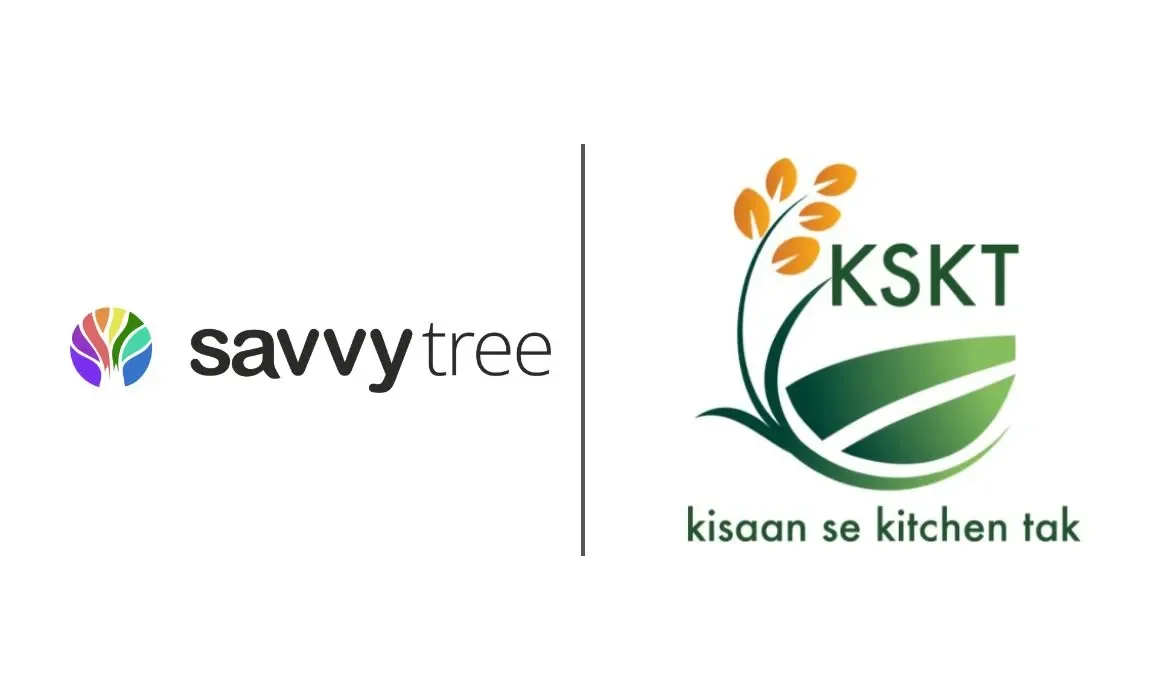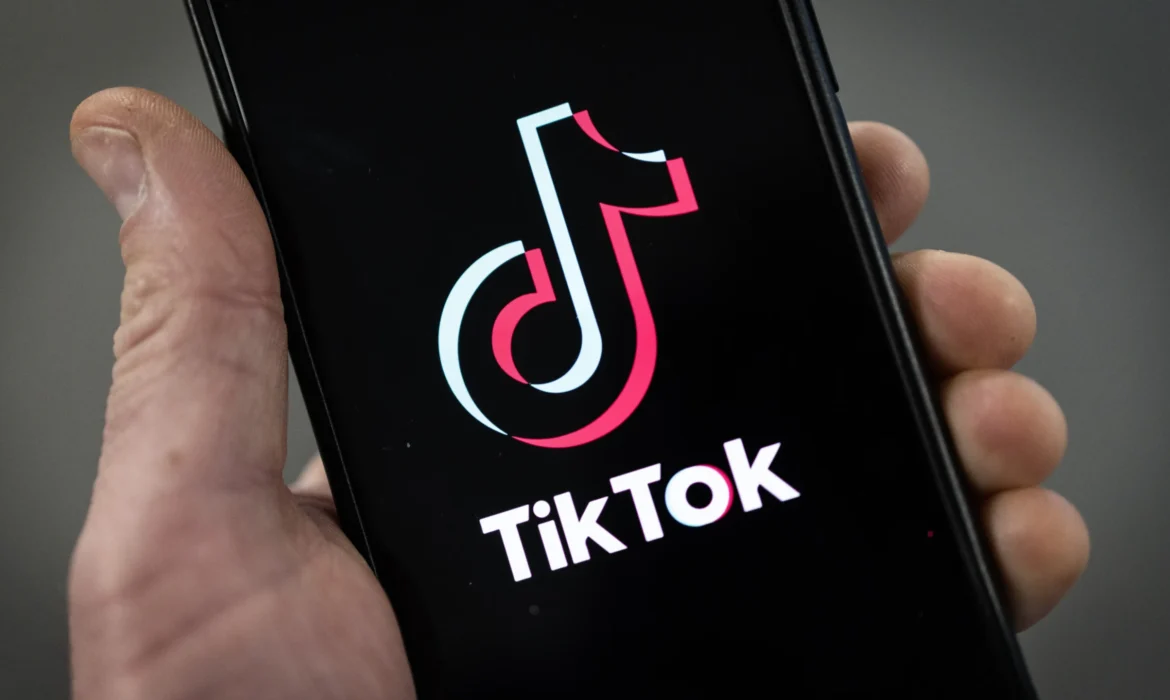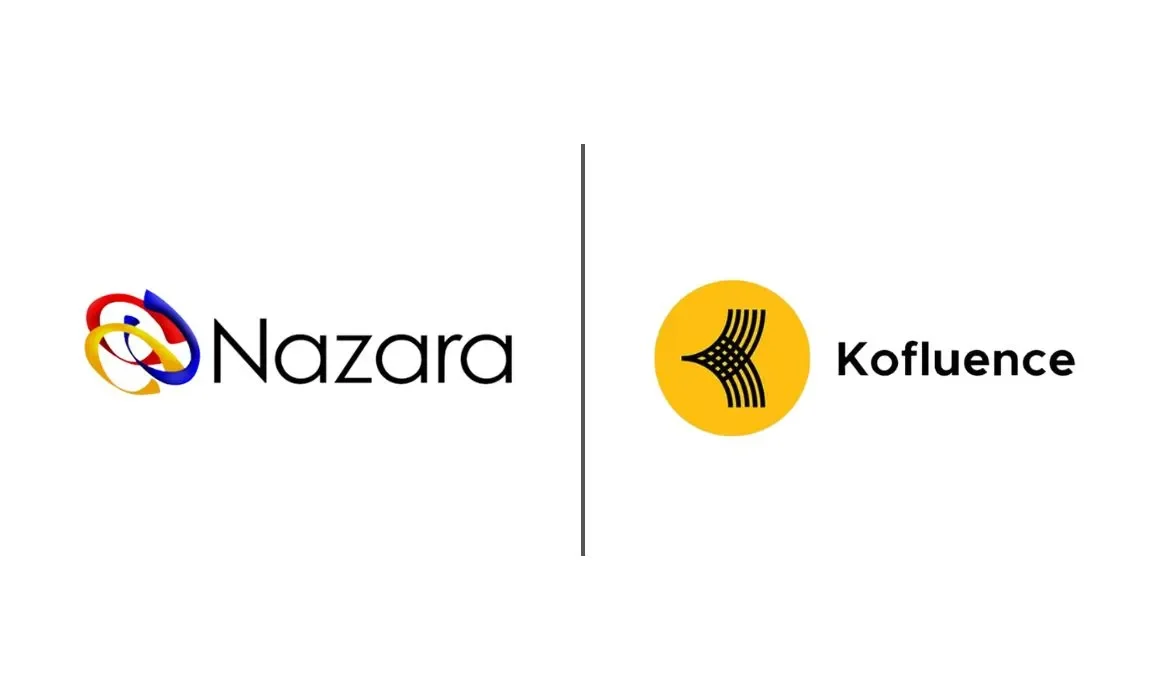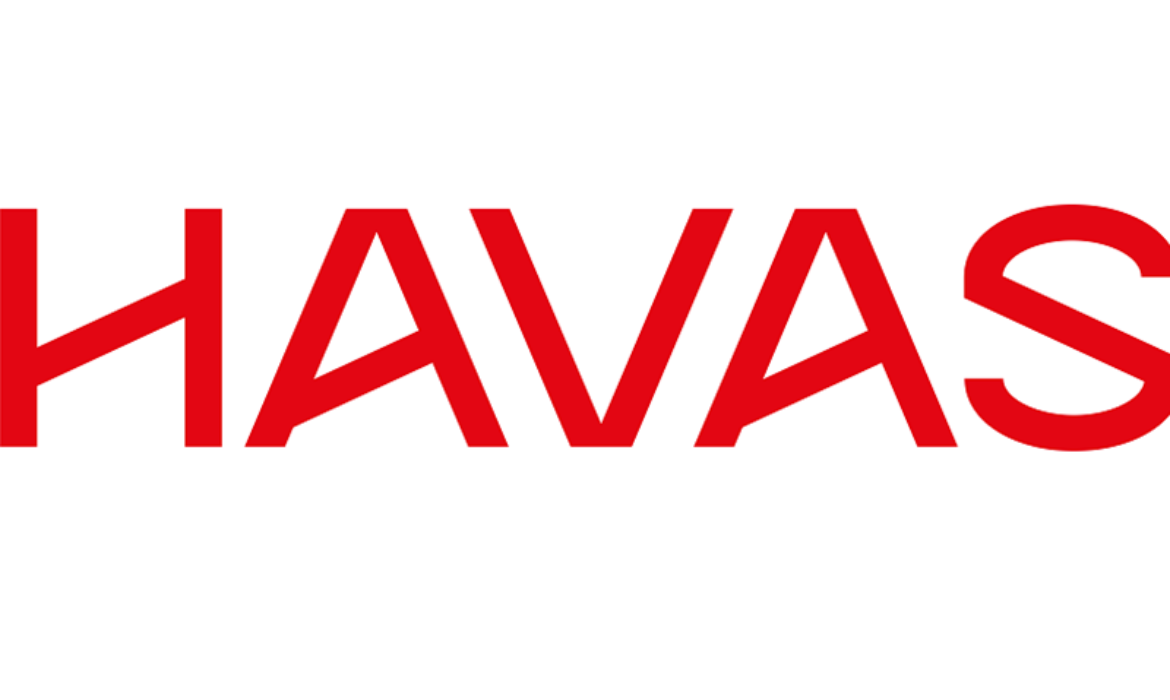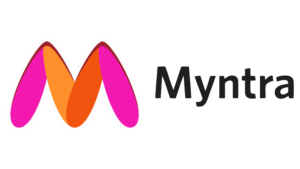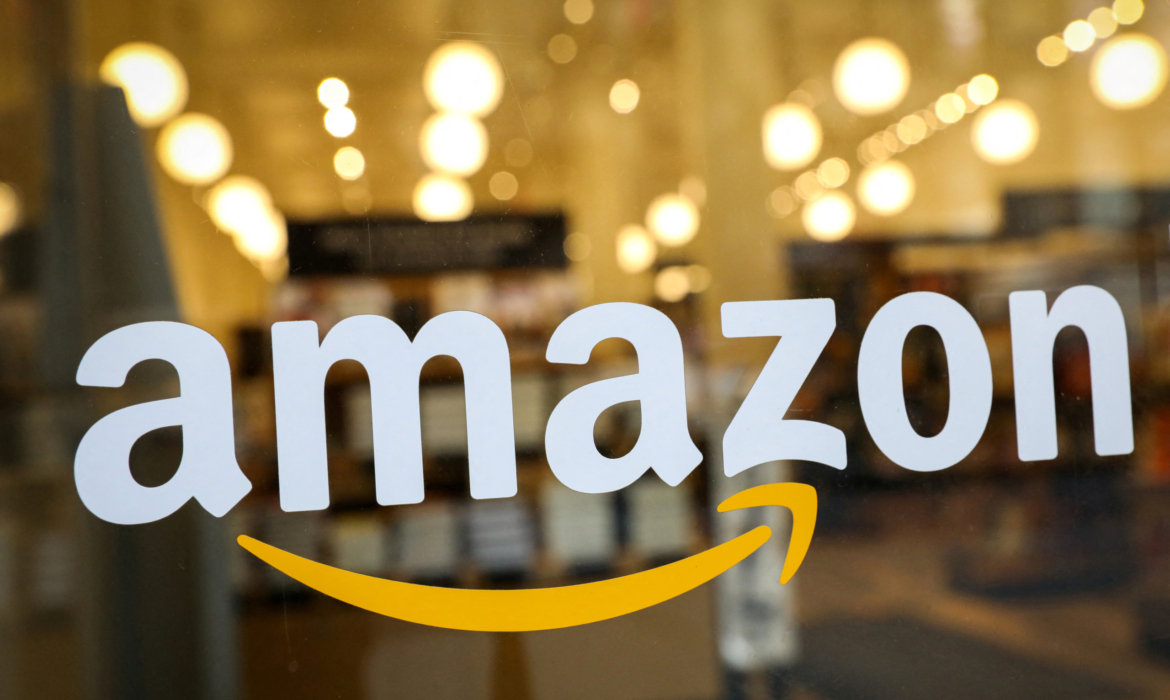Dentsu Creative Bags the Creative Mandate for Motorola India
Motorola has selected Dentsu Creative India as its creative agency. The agency, which will service the brand out of its Delhi office, won the mandate after a multi-agency pitch. The brand’s integrated campaign approach has been strategically enhanced by the addition of Dentsu Creative as a creative partner. It will thereby strengthen its overall marketing strategy.
Dentsu Creative wins Motorola India’s Creative Mandate
Dentsu Creative will lead a broad range of services across digital and mainline platforms per the mandate. Proposal development, planning, and strategy decks, planning and competition benchmarking, social media creatives, media requirements covering digital, ATL (above the line), and retail, as well as ORM (online reputation management) and social listening, are all included in this.
Motorola India’s brand integration enhanced
When it comes to creating campaigns for a wide range of clients, Dentsu Creative India is renowned for its integrated approach. Its collaboration with Motorola India not only demonstrates its dedication to quality. It also solidifies its standing as a reliable creative partner in the sector. Dentsu Creative PR and iProspect, two Dentsu India agencies, are in charge of Motorola India’s PR and media relations, respectively.
Read More: Omnicom Secures Creative Mandate for Air India Express
Here’s what they said
Shivam Ranjan, marketing head, Motorola Asia Pacific said,
“We are excited to onboard Dentsu Creative as our creative partners, their innovative approach, digital-first thinking and strategic acumen make them the perfect partner to accelerate Motorola’s core business narrative. Their in-depth research capabilities, industry expertise and creativity seamlessly align with our vision. We look forward to collaboratively delivering impactful and memorable campaigns to our audience.”
Ujjwal Anand, managing partner, Dentsu Creative India added,
“We are honored and excited to commence this creative journey with Motorola India. We are optimistic that our belief in modern creativity, an approach that resonates with today’s dynamic landscape, will contribute to the success of meaningful campaigns for Motorola. We look forward to crafting innovative narratives, breaking traditional boundaries, and contributing to Motorola’s success in the vibrant and ever-evolving Indian smartphone market.”
Read More: Gozoop Secures the Creative Mandate for The LEGO Group In India
Dentsu Announces Extension of Mandate with TTK Healthcare
Dentsu Creative India has announced the extension of its mandate with TTK Healthcare, a well-known healthcare products company. Now, the agency will oversee media and social media responsibilities for Skore, Eva, and MsChief, three of its brands. The agency’s Mumbai office will handle account management.
Dentsu Creative India expands mandate for 3 TTK Healthcare brands
It is important to highlight that Dentsu Creative has long been a dependable partner of TTK Healthcare, beginning with cutting-edge brands of sexual wellness and pleasure, such as Eva, a pioneer in the field of female personal enhancement, and Skore. The agency has proven its excellence and commitment by taking on another brand with ease: MsChief, TTK Healthcare’s most recent entry into the sexual pleasure market, specifically aimed at women. The agency’s ability to produce exceptional results for each brand—demonstrating exceptional capabilities that have earned them an expanded role and responsibilities—was the driving force behind this decision.
End-to-end social media and performance media mandate
Dentsu Creative India will supply the three brands with comprehensive social media and performance media solutions following the mandate. The agency will use its knowledge of digital to produce compelling digital ads. The range of work involves creating aesthetically pleasing digital creatives, managing social media platforms, strategically planning and acquiring media, and carrying out content marketing plans for the brands.
Read More: Dentsu Expands Partnership With AWS To Scale GenAI Capabilities
Here’s what they said
Speaking on the win, Arjun Siva, DGM – Digital Marketing & eCommerce, TTK Healthcare said,
We are delighted to extend our relationship with Dentsu Creative and add MsChief to the set of brands that we partner on with them. We’re confident their proven expertise and consolidated creative and media strengths will help us enhance our digital presence and drive business for our brands.
Sahil Shah, President – Digital Experience, Dentsu Creative India added,
With this consolidation, we have further solidified our position in strengthening TTK Healthcare’s digital efforts. And, for us, the most exciting part is that we are able to see through end-to-end digital – creative, media, and data included – for these ambitious challenger brands. I am extremely confident that we will deliver both brand and business results through the power of integrated digital for TTK Healthcare brands.
Manika Juneja, Managing Partner – Digital Experience, Dentsu Creative commented,
We are ecstatic to strengthen our collaboration with TTK Healthcare! Our journey began with Skore & Eva, and now, with the addition of MsChief, we are truly grateful. Our team is poised to inject integrated digital excellence into these brands, ensuring they not only stand out but thrive. The ongoing partnership promises exciting success, and we look forward to achieving new heights with TTK Healthcare as our valued partners.
Read More: Dentsu Creative India Wins Digital Mandate For 4 Sony Channels
Savvytree Wins Digital Marketing Mandate for Kisaan Se Kitchen Tak
Savvytree has taken over Kisaan Se Kitchen Tak‘s digital presence. Delhi-based Savvytree, a digital marketing agency, has revealed that it has acquired full digital marketing responsibility for Kisaan Se Kitchen Tak (KSKT Agromart). KSKT is a business that promotes fresh, pure, and naturally grown agricultural products.
Savvytree takes over KSKT’s digital marketing mandate
Savvytree will oversee KSKT Agromart’s digital marketing initiatives as part of the partnership, which will include social media management, content creation, and performance marketing. Through this strategic alliance, KSKT Agromart hopes to reach a wider audience and increase awareness of the value of utilizing natural and pure farming methods.
What does Kisaan Se Kitchen Tak do?
Kisaan Se Kitchen Tak sets itself apart by supporting farmers’ causes, empowering them in agriculture, and encouraging healthy living through their produce. The group actively promotes income growth for farmers while opposing the use of hazardous chemicals in farming. In addition to guaranteeing the best produce for customers, KSKT Agromart promotes environmental health. It uses organic and sustainable farming methods.
Read More: DoubleVerify Expands Media Authentication on Meta
The organization acknowledges the important role that women play in agriculture. Furthermore, it gives them the resources and information they require to become independent members of the farming community. This benefits the economic standing of women and enhances the agricultural environment.
KSKT’s business strategy
Apart from spearheading Kisaan Se Kitchen Tak’s digital marketing initiatives, the company’s business strategy encompasses the establishment, procurement, or leasing of various business divisions. These are tailored to particular products, customer segments, sales channels, and geographical regions. Together with shared functional teams like marketing, finance, and IT, these discrete business units are connected by a single backend supply chain.
Commitment to agriculture
KSKT Agromart is committed to transforming the agricultural landscape. It looks to implement contemporary business practices that align with its core values of empowerment, sustainability, and purity. This is demonstrated by its collaborative and integrated approach.
Read More: VICE Media Group Names Rafael Lavor As Head of Strategy
TikTok Testing New Feature To Make All Video Posts Shoppable
TikTok has begun testing a feature that will make all video posts shoppable, the latest step in the social media company’s efforts to build a multibillion-dollar e-commerce business in the United States. With this new feature, objects in a video can be automatically identified by technology. After that, it prompts users to click on a product page on the TikTok Shop to find comparable items. Before, products could only be tagged by brands and approved influencers in content uploaded to the app. The company introduced a TikTok shop in the US last year in an attempt to merge product discovery with shopping.
TikTok Shop launched in the U.S.
To bring together the convenience of Amazon.com Inc. shopping with the product discovery capabilities of social media platforms like Instagram, the Chinese social media company launched the American version of TikTok Shop last year. The company, which hopes to sell $17.5 billion worth of goods in the United States this year, has made this new project a top priority. But reviews of Shop’s debut have been conflicting thus far.
Read More: Amazon Ads and IPG Mediabrands Ink 3-year Deal for Upcoming Prime Video Ads
TikTok’s aim to make video posts shoppable
After witnessing record-breaking sales, merchants praised and cheered the app, with TikTok financing discounts and free shipping. Users, however, have taken issue with products that are sold on TikTok’s marketplace that are knockoffs and counterfeit. Some claim the experience is being ruined by the abundance of influencer posts that resemble advertisements.
Over 5 million new customers made purchases back in November. On the other hand, consumers have been grumbling about knockoffs and counterfeit goods being offered for sale. Some claim that the experience is being destroyed by ad-like posts. The company incentivizes creators to promote merchandise by paying them commissions on product purchases made from their posts.
TikTok’s Strategy
To address these issues, a new feature that is currently undergoing testing links products to posts made by regular users without making a strong sales pitch. This strategy aims to give guests who are primarily looking for entertainment a more pleasurable experience. Even though the new feature is still undergoing testing, it has already demonstrated improvement potential.
Read More: TikTok and HubSpot Partner for CRM Integration to Boost Lead Generation
Nazara Technologies Announces 10.77% Stake in Influencer Platform Kofluence
Nazara Technologies Limited, an India-based diversified gaming and sports media platform, announced that its board has approved a share swap with certain existing Kofluence investors to acquire a 10.77% stake in Kofluence Tech Private Limited. It is anticipated that the acquisition of stakes will aid Nazara in creating a platform for influencer-led game discovery.
Acquisition of a Minority Interest in Influencer MarTech Platform Kofluence
Nazara Technologies is proposing to issue 3,71,637 shares at a price of INR 872.15/- per equity share, aggregating to INR 32.41 crore, as a preferential issue on a private placement basis to the seller in connection with the share swap transaction.
What does Kofluence do?
Kofluence is the top marketing-tech platform for social media influencers in India. It boasts over 600,000 registered creators across 20+ languages on Instagram, YouTube, Facebook, LinkedIn, and Twitter. Kofluence is a full-stack marketing platform that focuses on generating awareness, interest, desire, and action to meet performance metrics. Kofluence has assisted brands in leveraging social media creators to create value, having worked with more than 500 prestigious clients in 20+ sectors.
Influencer-led Social Game Discovery Platform
Nazara Technologies and Kofluence plan to launch an influencer-driven game discovery platform. Influencer marketing will be employed in this project to advertise Nazara’s games across multiple social media channels. Influencers can customize their content to the tastes of their followers, generating excitement about new releases and encouraging downloads. This strategy helps Nazara break into a variety of market niches by increasing the visibility of its games, enabling targeted marketing, and providing direct performance feedback.
Here’s what they said
Nitish Mittersain, Jt. MD & CEO of Nazara Technologies said,
Kofluence is pioneering creator economy led platforms and Sreeram’s extensive gaming experience is invaluable to create a pioneering influencer led game discovery platform and community. Our goal is to create an environment where gaming collaborates with the creativity of influencers, enriching the gaming experience for a global audience. Our new game publishing initiative ‘Nazara Publishing’ will particularly benefit from this new initiative”
Sreeram Reddy Vanga, Co-founder, and CEO of Kofluence stated,
Nazara’s investment is a powerful validation of our joint mission to revolutionize the gaming industry. With our extensive network of over 600,000 creators, we’re well-positioned to greatly enhance the visibility and engagement of Nazara’s gaming portfolio. This partnership is not only expanding Nazara’s game reach but also reshaping game marketing dynamics, bringing every creator and user into an expansive and captivating gaming narrative.
Read More: Nazara Technologies Partners with 4 Gaming Studios to Publish 5 Games
CGI Advertising: Pioneering Future of Marketing or Merely a Social Media Fad?
Technology integration has always been a driving force behind change in the dynamic world of advertising. In the realm of marketing, captivating images can do wonders for capturing customers’ attention and making a lasting impression. Computer-generated imagery (CGI) is one such invention that has drawn interest from both consumers and marketers. It is a state-of-the-art technique that allows imagination to come to life in advertisements. CGI has completely changed how people relate with brands, from mesmerizing product advertisements to enticing brand marketing.
The unseen hero of the advertising industry, computer-generated imagery (CGI) subtly intervenes to realize seemingly unattainable goals. When utilized skillfully, computer-generated imagery (CGI) has the power to transform a commercial from ordinary to spectacular, producing moments that stay with the audience long after the TV is turned off. But the question remains: Is CGI advertising a precursor of things to come in the marketing industry, or is it just another passing social media fad?
What is CGI advertising?
CGI OOH, also known as CGOOH or “Faux-out-of-home” (FOOH), is a new marketing strategy that is about to be implemented. The use of computer-generated imagery (CGI) in advertising has become indispensable. CGI has been widely adopted by the OOH sector to create unique social media advertising. By using CGI in advertising, companies can now communicate their messages in more imaginative and eye-catching ways, drawing viewers in and increasing interaction.
The goal of CGI marketing material has changed over time, striving for a startling degree of realism and organic content imitation. Moreover, marketing directors and brand managers support these fictitious initiatives. CGI is the term for the skill of producing realistic visual content with the use of cutting-edge graphics and sophisticated computer tools. All media, including social media, online videos, and traditional television, have a proper role in advertising. CGI marketing initiatives, which are frequently witty, lighthearted, and designed to go viral, have become very popular on social media.
CGI in Advertising
This trend has its own implications and questions regarding production for design-build firms and brands that want to install physically. One important thing to keep in mind about CGI marketing campaigns is how easily they can be reposted and shared again without any additional information or credit. Because original sources and creators are only occasionally mentioned, viewers might conclude that these campaigns were actually created and put into action in real life. Digital content can make it difficult to distinguish between fact and fiction because it is vulnerable to the same issues that help fake news proliferate. Additionally, over time, it may increase brand credibility and trust.
Read More: Virtual Product Placement: The Newest Upstart in TV. Find Out How!
Rise of CGI Advertising
Nowadays, CGI is widely used in the majority of the media, entertainment, TV broadcast, and advertising sectors. Through digital renders, advertisers can produce realistic, high-quality virtual worlds and objects that aren’t actually there in the real world. On the other hand, it enables the construction of objects that are not real and might be too costly or difficult to capture on camera or photograph. Real-world environments or objects can be created much more quickly and affordably with the aid of CGI. These can be used in films, animated movies, and video clips; they can also be 2D, 3D, or even CGI animated.

Image credit- Buzzfeed
For a considerable amount of time, computer-generated imagery (CGI) has been used to bring various magical and imaginary characters to life. It is currently a standard component of the movies and television shows that people watch on a daily basis. However, it’s also critical to comprehend how CGI is currently used in other sectors, such as enterprise, corporate engineering, and advertising. To help brands and corporates better connect with their customers and clients, CGI is being used as a tool for product design and the creation of advertising content. Simultaneously, the objective is to produce better and more affordable goods. The use of CGI in content creation has grown significantly, and this trend is expected to continue as more and more content creators choose to use it instead of traditional media.
How CGI seamlessly integrates into various advertising channels
CGI frequently looks effortless as it appears on numerous advertising channels, almost like a magic trick. It all comes down to how adaptable and simple it is to integrate. CGI doesn’t just work in isolation; it collaborates with other media types to create a cohesive, powerful message.
- Television Commercials
- Social Media Advertising
- Digital Billboards
- Mobile and Web Apps
Television Commercials
One area where CGI really shines is in TV commercials. Here, it either takes center stage or collaborates with live-action video to produce breathtaking visual effects. Commercials with such striking visuals have the power to stick in the minds of viewers and connect with a large audience while condensing complex ideas into a digestible format.
Social Media Advertising
Today’s social media is flooded with CGI-enhanced advertisements. Amidst the abundance of content, computer-generated imagery (CGI) adds a level of sophistication that draws the user in, whether it is an animated explainer video or a 3D product demonstration. Increased brand awareness and a higher CTR are correlated with visual engagement.
Digital Billboards
Modern digital billboards frequently have animated CGI that visually appealingly conveys the brand’s message. Because of the lifelike CGI presentation, this type of advertising—also known as digital-out-of-home (DOOH)—leaves a lasting impression.
Mobile and Web Apps
Numerous companies include specialized online or mobile applications in their customer engagement plans. By offering interactive features or graphics that improve user experience and promote brand loyalty, CGI improves these platforms. Advanced images can make people stay on a page longer, which increases the opportunity for businesses to interact with their audience.

Image credit- Render3quick

Image credit- Pixelsilo
Read More: A Lookback At the 5 Best Christmas Ad Campaigns of 2023
Benefits of CGI Advertising
Using CGI has certain advantages over traditional media. It must be acknowledged, though, that CGI is sometimes misinterpreted as an expensive medium to use. When one understands the truth, however, this couldn’t be far from reality.
- Cost reduction
- Efficient and Flexible to Produce
- Creating Buzz with Customer Engagement
- Limitless Opportunities
- Cross Platform Compatability
Cost Reduction
Because CGI works with virtual representations created by computer software, it can frequently be more affordable than traditional media. It does away with the necessity for costly location shootings, complicated set designs, and logistical difficulties. Furthermore, a CGI asset can be changed and utilized for future campaigns across all advertising platforms after it has been generated. Time, money, and resources are saved in this way.
Efficient and Flexible to Produce
CGI’s beauty is in its capacity to go beyond what is physically possible. Brands have the ability to dream large and even transform the most incredible concepts into real, visual experiences that pique the interest of their target audiences. Customers can inspect products from all sides with the help of hyper-realistic product renderings, which increases their confidence and sense of trust when making purchases. Building a virtual representation of a product or environment with 3D software offers far greater flexibility and allows for the creation of computer-generated renderings that eliminate the need for post-production retouching to remove unwanted artifacts from the scene.

Image credit- Marketing Mind
Creating Buzz with Customer Engagement
Higher engagement rates are a result of visually compelling content, and CGI elevates the game by enthralling viewers with its otherworldly charm. Social media shares of these eye-catching ads are more likely to occur, greatly increasing brand exposure and reach. Businesses can effectively showcase their offerings by using CGI to create stunning product images, interactive advertisements, virtual videos, and room scenes.

Image credit- Marketing Mind
Limitless Opportunities
There are countless opportunities to quickly and easily create and modify content with CGI. Customers who wish to introduce whole product lines or experiment with various settings throughout the day to test out various settings and environments will find great advantages in this. The only restriction when using CGI is one’s imagination. It could be defying the laws of physics, taking viewers to amazing places, or even breathing life into imaginary characters. The opportunities are endless, enabling the production of genuinely distinctive and engrossing commercials.
Cross Platform Compatibility
The adaptability of CGI is its best feature. The three most often used mediums of interaction are cell phones, tablets, and PCs; a significant portion of user interaction occurs on cell phones. Because audiences prefer familiarity, it is imperative to provide them with identical experiences across all platforms. Once the model is ready, it can be animated or even made into an interactive game using computer-generated imagery (CGI). It can be displayed on any screen, device, or media platform.
Constraints of CGI Advertising
While there are many benefits to using CGI in advertising, there are also potential drawbacks.
- Cost
- Authenticity
- Ethics
Cost
CGI can be costly, particularly when creating intricate or lifelike images. For startups and smaller companies looking to experiment with technology in their advertising campaigns, this can be a barrier.
Authenticity
When CGI is used to produce fictitious images of goods or services, some consumers may believe that the advertisement is deceptive or unauthentic. Furthermore, using CGI excessively can make a scene seem untrue. Advertisers that use traditional filming techniques risk losing the interest of audiences if they grow too accustomed to seeing CGI.
Ethics
The usage of CGI in ads raises additional ethical issues. These could involve the possibility of making false claims or misrepresenting products.
Future Trends in CGI
CGI is turning into a vital tool for virtual marketers as businesses strive to produce more captivating and immersive content. Let’s examine some upcoming changes in CGI technology and trends that digital entrepreneurs should be aware of.
- Real-Time Rendering
- AR (Augmented Reality) and VR (Virtual Reality)
- AI and Machine Learning
Real-Time Rendering
The era of real-time rendering is revolutionizing content creation in marketing. This makes it possible to create interactive and highly dynamic content by enabling the technology of real-time CGI. Real-time rendering enables marketers to create immersive reports, adjust to user interactions, and instantly personalize content.
AR (Augmented Reality) and VR (Virtual Reality)
Virtual reality and augmented reality technologies are increasingly being incorporated into online marketing and advertising campaigns. Marketers use AR and VR to create immersive logo storytelling, digital showrooms, and interactive product reviews. Given the anticipated growth in the use of AR and VR in advertising, it is imperative that digital entrepreneurs investigate the ways in which CGI can enhance these studies.
AI and Machine Learning
The application of CGI by marketers is being revolutionized by AI and ML. With the help of these technologies, business owners can analyze large datasets to gain insights into the behavior and potential of their customers. Additionally, this data can be utilized to produce more specialized and tailored CGI content.

Image credit- Ndigitec
Success Stories
Jacquemus
Internet absurdities are nothing new to Jacquemus! The upscale French fashion brand gained international attention in April when their cult-favorite Bambino purses were spotted wandering the streets of Paris. With millions of interactions, the campaign went viral online and expanded Jacquemus’s reach and brand recognition.
Maybelline
The Maybelline Sky High Mascara Express campaign quickly became viral on social media. Popular forms of transportation were featured in short films posted on Maybelline’s Instagram, with life-size mascara brushes brushing back their oversized eyelashes. Customers became more aware of Maybelline’s new product due to the campaign, which highlighted it.
Barbie
Who can forget the viral Barbie campaign that went viral on the internet? A massive Barbie appeared in front of the Burj Khalifa in Dubai prior to the Barbie movie’s premiere. Despite having nothing to do with Barbie’s official marketing campaign, the video created curiosity and made sure that the film was in everyone’s thoughts.
Just a social media fad?
There is also the belief that CGOOH is a passing trend. Many believe that it is excessive. People are starting to grow tired of the fashion. But is it truly their fault? It was received and embraced so quickly that nobody had a chance to recognize its potential fully. It is necessary to examine the possibility at this point. Nevertheless, savvy brand managers and agencies intend to go beyond this. However, where it goes from here will be what sets it apart.
Some claim that since the field is constantly changing, marketers will need to adapt. Evolution is the obvious solution! There will always be new technologies, but what will set them apart is how skillfully they are used to convey compelling stories and leave an impression.
Final Words
Brand-audience relationships have been transformed by CGI marketing. By telling gripping stories and arousing feelings, CGI produces memorable experiences that have a profound impact on customers. Using CGI in advertising can lead to more creative and appealing ads, as well as the ability to simplify and communicate complex ideas. CGI is expected to become a digital marketing backbone as this revolutionary technology gains traction and creates captivating connections with viewers unlike anything seen before.
Read More: Magna Global’s Hatem Fakih Reveals Strategies for Thriving in GCC’s Media Landscape
Havas Acquires EPROFESSIONAL, a Hamburg-based Digital Performance Marketing Agency
Havas has declared the strategic acquisition of EPROFESSIONAL, a digital performance marketing agency located in Hamburg. This move will broaden the company’s offering of premium performance marketing services and solidify its standing as the top agency in Germany. EPROFESSIONAL will become a part of the Havas Media Network organization while maintaining its independent branding.
EPROFESSIONAL, a Hamburg-based digital performance marketing agency
EPROFESSIONAL, which was established in the attic in Hamburg in 1999, has gained a reputation for being a leader in the performance marketing industry and a supplier of unique solutions. The company is a skilled collaborator in all facets of digital marketing, including social media, multichannel tracking, SEO/SEA, and more. For many years, EPROFESSIONAL has worked well with clients like Vodafone, L’Oréal, and Hapag Lloyd.
Management Roles
Henner Uekermann, who will take on the position of Managing Director, will oversee EPROFESSIONAL alongside Tim Christiansen. In parallel, Henner will carry on in his capacity as Managing Partner of Arena Media, a German agency brand that functions as a second brand under the Havas Media Network, alongside Havas Media.
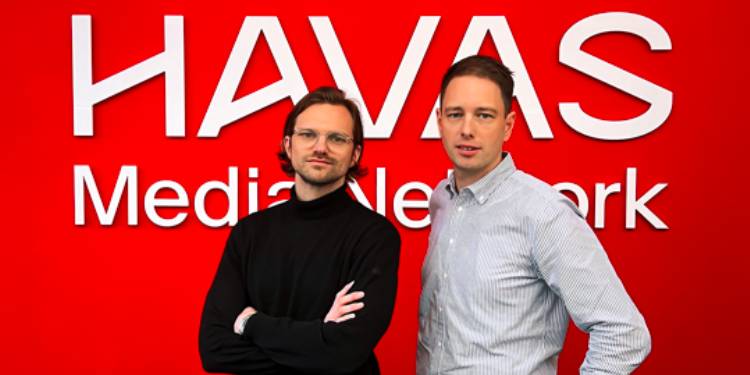
Left-Tim Christiansen; Right- Henner Uekermann; Image credit- MediaNews4U
Read More: Havas ME’s Alejandro Fischer: Shaping Advertising’s Landscape with Tech Brilliance
Here’s what they said
Yannick Bolloré, Chairman and Global CEO, Havas said,
We are thrilled to welcome EPROFESSIONAL to the Havas family. By combining EPROFESSIONAL’s expertise with our group’s local and global resources, we further strengthen Havas Media Network in Germany, ranked “dominant” in the latest RECMA report, and are better equipped to deliver best-in-class digital marketing solutions to our clients. After making investments in the UK, Canada, and India, our objective is to further expand our digital performance capabilities worldwide.
Sven Traichel, CEO of Havas Media Germany, explained
The focus has always been on making strategic and, above all, locally relevant investments. The acquisition of EPROFESSIONAL is such an investment to expand our digital expertise and offer customers even greater added value. The merger will enable both Havas and EPRO customers to implement successful marketing measures at all touchpoints of the entire customer journey.
The Managing Director of EPROFESSIONAL, Tim Christiansen, added,
Havas is an ideal partner for us. We share the same vision of offering customers innovative and customized solutions. In addition, the chemistry on a human level is outstanding.
Henner Uekermann, approaching his new role with great enthusiasm commented,
The integration of EPRO into the Havas Media Network and the further development of Arena Media in Germany are two wonderful tasks for me. With EPRO’s technological solutions and Havas Media’s 360° approach, we can implement holistic strategies from the first touchpoint to conversions and achieve our clients’ growth targets effectively and efficiently. By combining our competences, we can offer our clients an absolute state-of-the-art product from which we expect our agency to continue to grow in the coming years.
Read More: Swiggy To Continue With Havas Media Group India for Media Duties
Meity Gives Social Media Companies 7-days to Modify User Agreements Against Deepfakes
Rajeev Chandrasekhar, India’s Union Minister of Electronics and Information Technology (MeitY), stated that if users are offended by obscene material such as deepfakes, the government will help them file a formal complaint against social media companies for breaking IT regulations. To discuss this matter, a meeting was called with a few of the most important digital platforms or intermediaries in India. The Union Minister added that social media companies have seven days to update their terms of service in accordance with IT regulations. In addition, he stated that the Center would shortly appoint an officer to combat the threat.
#WATCH | On Deep fake issue, MoS Electronics & Technology Rajeev Chandrasekhar says, "The Rule Seven officer will also be a person who will create a platform where it will be very easy for citizens to bring to the attention of the Government of India their notices or allegations… pic.twitter.com/AHiATR6DD4
— ANI (@ANI) November 24, 2023
Cracking the whip on deepfakes
In an effort to crack down on deepfakes, the union government has given social media companies seven days to modify their user agreements. This is so they comply with IT regulations. The amended account policy prohibits users from participating in 11 categories of content. These include deepfakes, that cause harm to other users. Meity is going to create a platform where people can report social media platforms that are breaking IT rules. Additionally, Chandrasekhar stated that going ahead, 100% of IT rule violations will result in government action.
Read More: Adobe Acquires Indian AI-Powered Platform Rephrase.ai
Meity extends its assistance to file a formal complaint
Meity will assist in filing a formal complaint against harmful content. A case will be brought against the person who posted the content if they assist in identifying its source. The Minister announced that India will create new regulations to identify and stop the spread of deepfakes following meetings with officials from major social media companies and other interested parties. Additionally, the new rule will make it easier for individuals to report these kinds of deepfake videos.
Rules concerning deepfakes
Deepfakes and other unsettling content ought to be taken down within 36 hours of being reported. Intermediaries are required by law to stop the spread of false information. Producing and disseminating deepfakes carries a fine of INR one lakh and a three-year jail sentence.
Here’s what they said
Union Minister of Electronics and Information Technology, Rajeev Chandrasekhar said,
It is a legal obligation for online platforms to prevent the spread of misinformation by any user under the Information Technology (IT) rules, 2021. They are further mandated to remove such content within 36 hours upon receiving a report from either a user or government authority. Failure to comply with this requirement invokes Rule 7, which empowers aggrieved individuals to take platforms to court under the provisions of the Indian Penal Code (IPC). It is imperative that platforms take proactive measures to combat this threat. For those who find themselves impacted by deepfakes, I strongly encourage you to file First Information Reports (FIRs) at your nearest police station and avail the remedies provided under the Information Technology (IT) rules, 2021.
Read More: India Launches IWBDC In a Drive For “Aatmanirbhar Bharat”
How Ad Ops is Revolutionizing the Indian Advertising Landscape
Welcome to the world of ad operations, where advertising and optimization meet chaos and order, respectively. Ad operations are the foundation of the monetization strategy in the realm of digital marketing. Its function is basic. Make sure the publishers serve the right advertising at the right times. The management and optimization of digital advertising initiatives fall under this category. Ad operations have changed significantly over time. According to a 2022 forecast, revenue for ad media owners will increase by around 6% globally to a record-breaking $865 billion in 2023. As the decade progresses, it is predicted that the annual sum will rise even higher, hitting one trillion dollars by 2026.
Ad Ops is a crucial part of any publisher’s system. It is in charge of overseeing internet sales of digital advertisements and is the most profitable cash cow. In essence, it is a crucial element of ad tech. But what precisely are Ad Ops?
An Introduction to Ad Operations
Ad Ops, often referred to as Digital Ad Operations, is the term used to describe the systems and procedures that enable the management and delivery of digital advertisements. The term refers to any method used by a marketing team to manage, carry out, or improve advertising campaigns. Although there are more than a billion websites, it would be extremely expensive for advertisers to have their adverts seen by everyone around the globe. Instead, companies can attempt to target their ads at individuals who most closely match their existing customers using digital advertising markets. Here’s where ad ops come in.
They are in charge of placing the ads based on the likely audience, time zones, places, and regions. It will generate income in return through advertising initiatives. Ad operations technology links advertisers looking to buy ad space with websites that offer ad space for sale. Despite the fact that the majority of digital ad spaces are sold programmatically and without human intervention, ad operations play a significant role in setting up and overseeing these procedures.
Key Components
Ad operations is the fusion of many technological methods, tools, and stakeholders. The main categories in which the key elements of ad operations fall are:
- Ad trafficking
- Creating and managing ads
- Delivering and targeting ads
Ad Trafficking
Ad Trafficking means setting up and implementing an advertisement campaign so it runs in line with its goals.
- Scheduling – One of the crucial tasks for Ad Ops is to correctly decide and operate pre-fixed schedules for launching and running ads considering the timing of an ad is a key.
- Optimization – One of the most important benefits of digital advertising is the ability to get precise, real-time data on consumer behavior and advertising engagement.
Creating and Managing Ads
Involves choosing ad formats, developing ads, and managing marketing campaigns. To guarantee that ads are properly created and handled, ad ops specialists collaborate closely with advertisers and publishers.
Delivering and targeting ads
Professionals in ad operations employ a variety of targeting strategies, including behavioral and demographic targeting.
- Ad Performance Analytics – To optimize ad campaigns and boost performance, Ad Ops specialists track and analyze data on ad performance.
- Privacy and Ad Compliance – Ad Ops experts must make sure that ads are delivered in a way that respects user privacy and adheres to applicable laws.’
Read More: 10 Game-Changing AI Tools for Digital Marketing in 2023
Advertising Landscape in India
With cutting-edge digital technology becoming more popular than ever in the market, the Indian advertising sector is set to reach new heights. Due to the pandemic, the advertising industry has been struggling to survive the past two years. However, indications show that the Indian advertising sector has been progressively recovering. The market size was INR 743 billion in 2022, and by 2028, it is anticipated to be INR 1,412.5 billion. It has a growth rate of 11%. The Indian advertising industry is expanding at an unprecedented rate, and digital advertising is flourishing. In an effort to reach the target demographic, brands and advertisers are using agile strategies to use digital advertising.

Image credit- Research and Markets
With every second that goes by, the Indian advertising scene continues to grow. Advertising experts adopted a 360-degree strategy as technology improved to include existing and upcoming digital media. Advertising in India, a now-vast industry, is set on being the second-fastest growing advertising market in Asia. It is now more data-driven, with thorough client journeys, mass-customized messages, and attractive deals.
Benefits and Drawbacks of the Ad Ops in the Advertising Landscape

Read More: Cracking the CRED Code: A Deep Dive into its Advertising Mastery
Case Study for Brands Who Leveraged Ad Ops
In India, Zomato is a well-known B2P app for food delivery. Zomato’s excellent marketing campaign has been one of the primary causes of this enormous increase in revenue. It has made it a priority to connect with its target market consistently. Zomato grew when internet marketing became mainstream in India. For instance, appealing ad words on billboards and SMS messages to the target population showed a firm belief in their advertising skills.
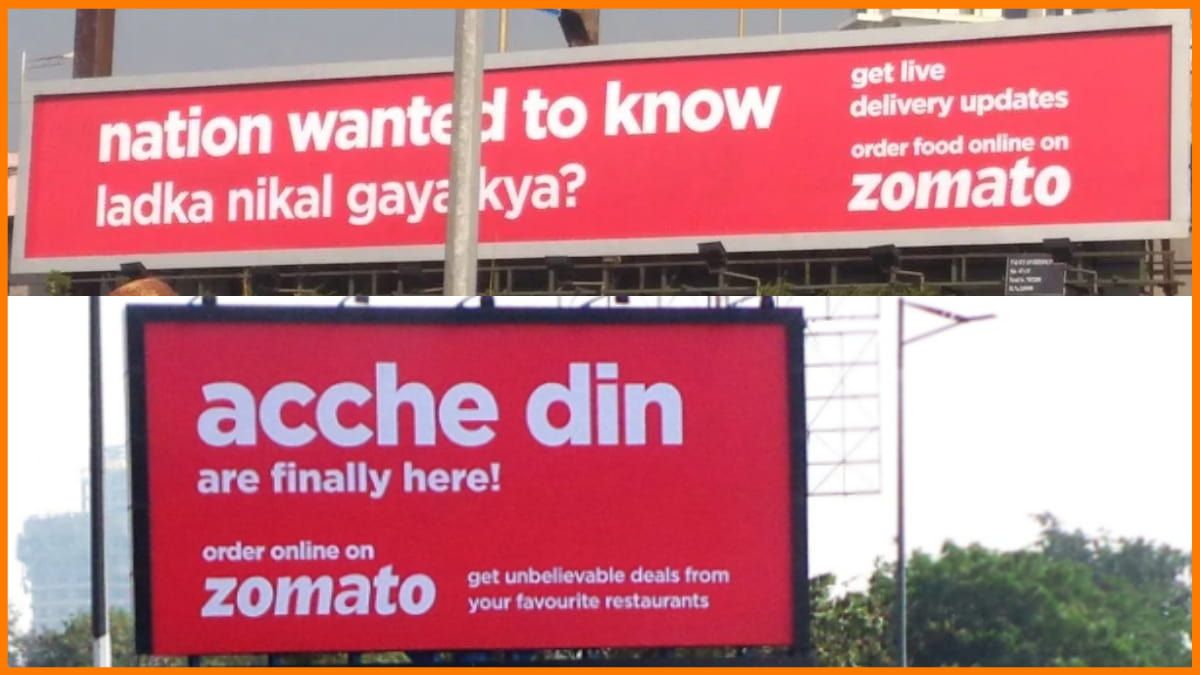
Image credit- Startup Talky
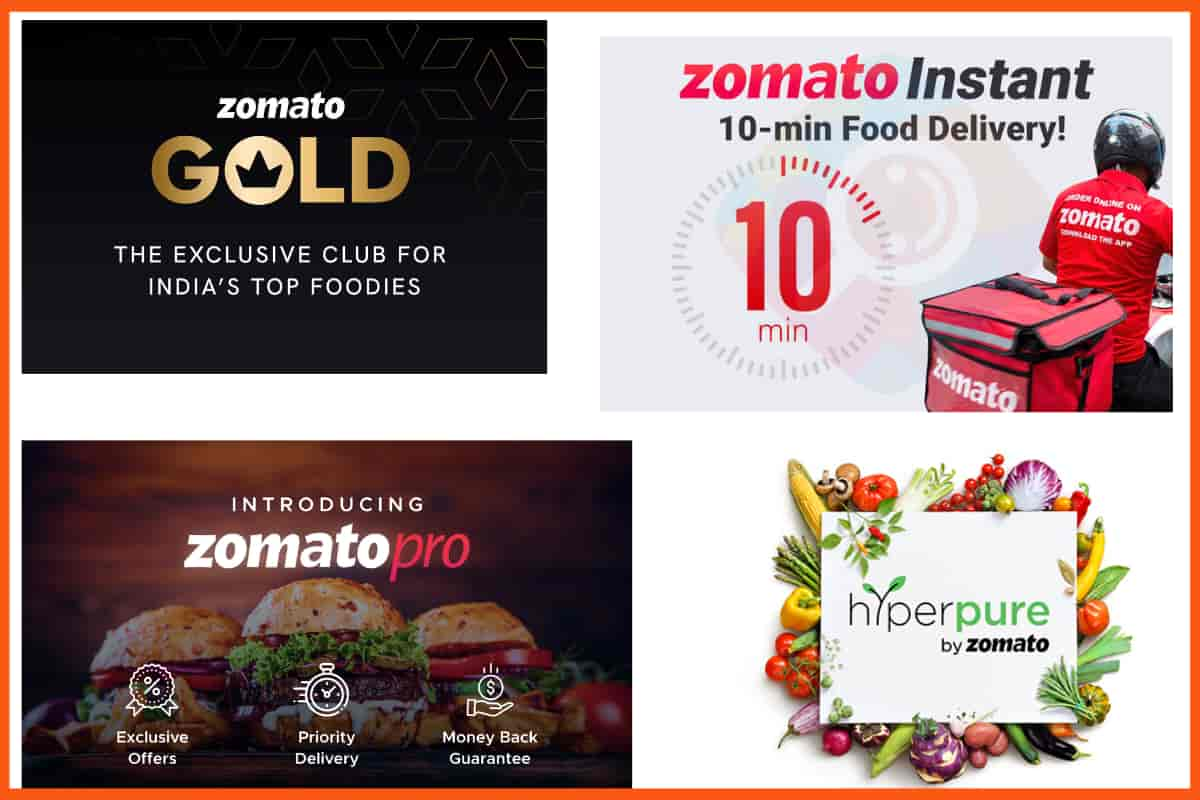
Image credit- Startup Talky
Here are some ways that Zomato’s marketing and ad operations techniques contributed to the app’s success.
- Wide-range and Powerful Outreach
- Email Tactics
- Using Social Media
- SEO Efficiency
Wide-range and Powerful Outreach
Zomato used a variety of outreach strategies in its marketing initiatives. It involves paid advertisements, email and SMS lists, and social media strategy. They studied consumer traits, ordering trends, and peak ordering hours to tailor ads for Zomato’s user base.
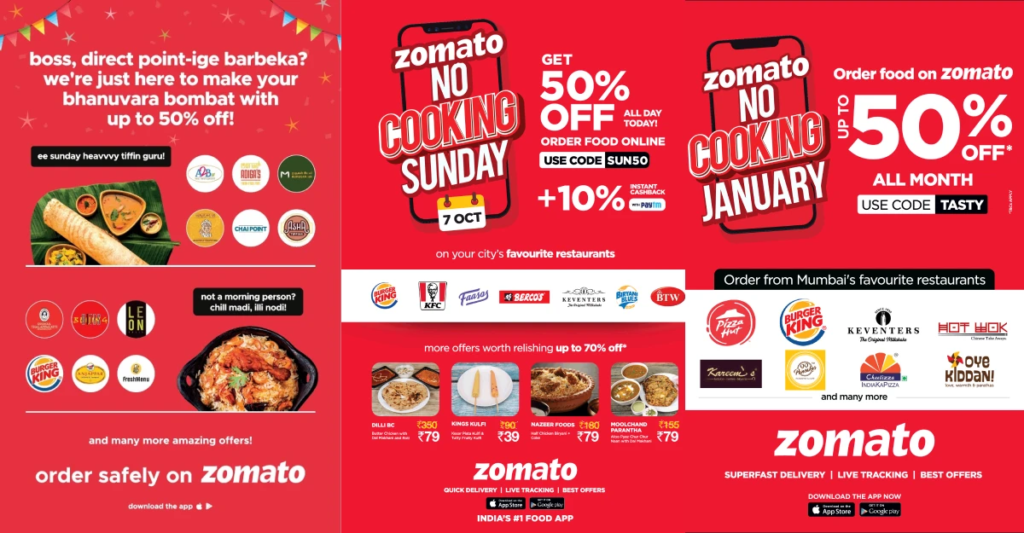
Image credit- The Business Rule
Email Tactics
Zomato targeted a potential niche by curating its emails to implement marketing strategies centered on the binge-watching culture that goes hand in hand with food.
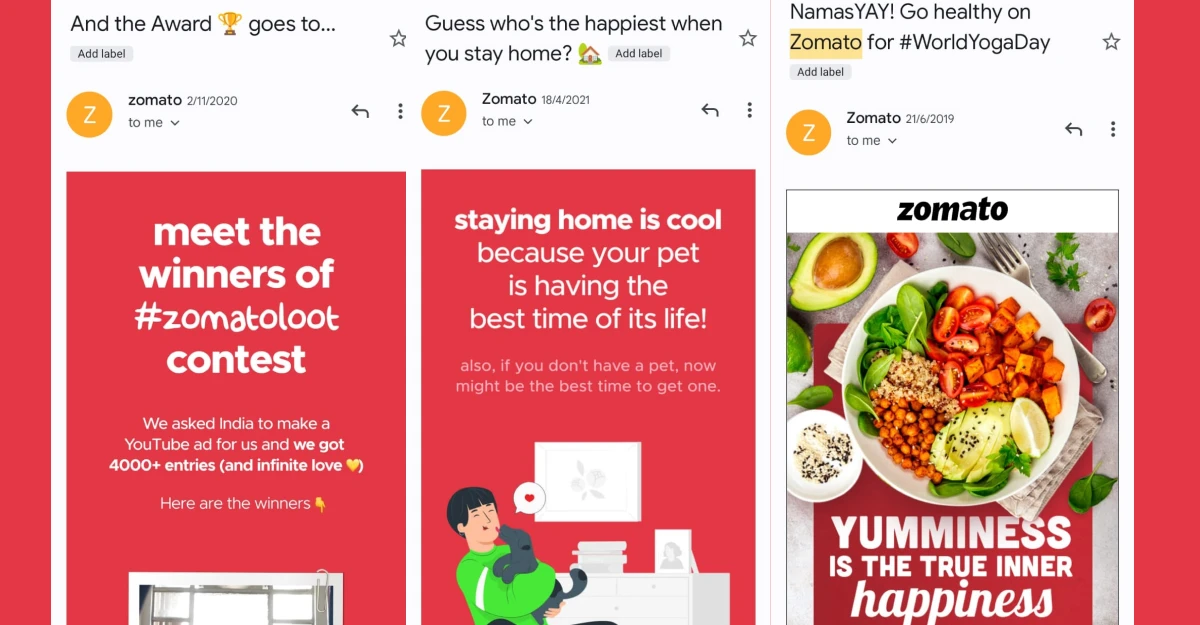
Image credit-The Business Rule
Using Social Media
Zomato depicts itself on social media with postings that are engaging on an emotional level. They interact in regional languages and make humorous memes to participate in meme

Image credit- Social Samosa via Facebook

Image credit- The Business Rule
SEO Efficiency
Zomato has produced extremely keyword-dense material that has drawn more than 67 lakh internet visitors.
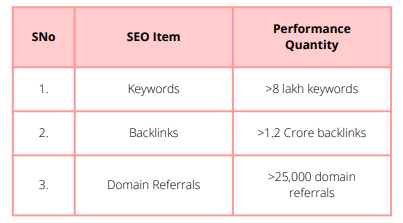
Image credit- iim skills
Zomato has a lot of influence because of its unique strategy of putting novel concepts into action on various fronts. It has always been a top priority for them to pay heed to customer comments and answer as soon as feasible.
Read More: An Innovative Triumph: Burger King x Stevenage FC Case Study
Myntra, a top-tier Indian online apparel retailer, boasts a remarkable “rags-to-riches” journey. Renowned for quality products and stellar customer service, its marketing plan revolves around key pillars for success.
- Content Marketing
- Social Media Marketing
- SEO Efficiency
- Paid Advertising
Content Marketing
Myntra has a popular blog that discusses a wide range of fashion, lifestyle, and trend-related topics. This makes the site one of the most well-liked fashion blogs in India. It leverages content marketing to establish connections with other brands and influencers.

Image credit- Myntra
Social media marketing
Myntra keeps a strong social media presence to ensure its target audience is always aware of the latest content. It routinely undertakes social media campaigns that support the development of the brand’s feeling of community. Additionally, it assists in providing a supply of user-generated material for advertising needs.
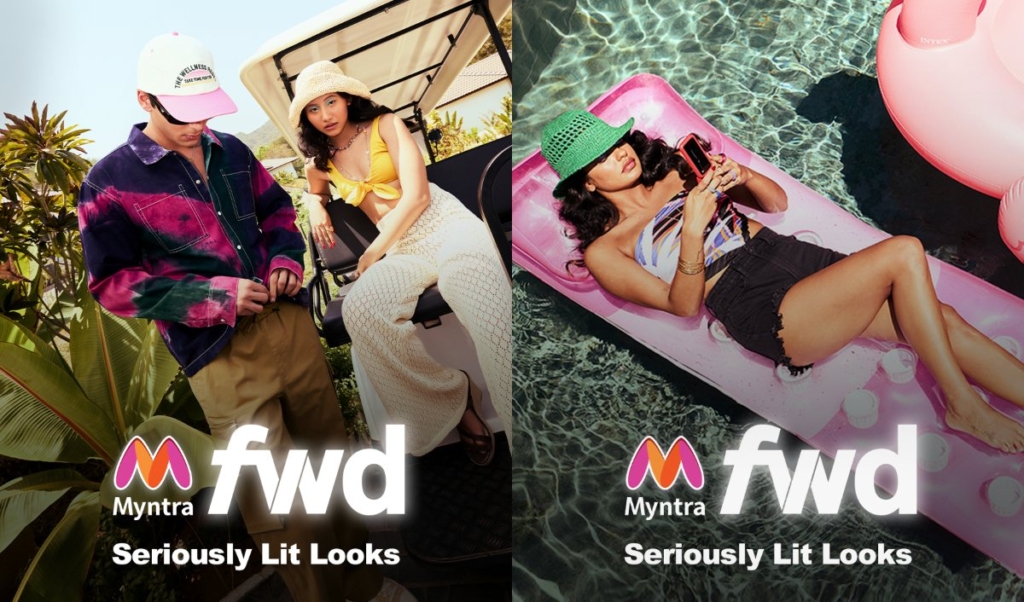
Image credit- Indian Retailer
SEO Efficiency
Myntra makes use of SEO to make sure that its website ranks as highly as possible for the right keywords. To do this, they incorporate relevant keywords and phrases into the website text.

Image credit- Madhu Sudanan via LinkedIn
Paid Advertising
Myntra promotes its website and goods through paid advertising. They employ a variety of strategies, such as display, retargeting, and pay-per-click (PPC) advertising. These techniques enable Myntra to efficiently promote its brand to a large audience.
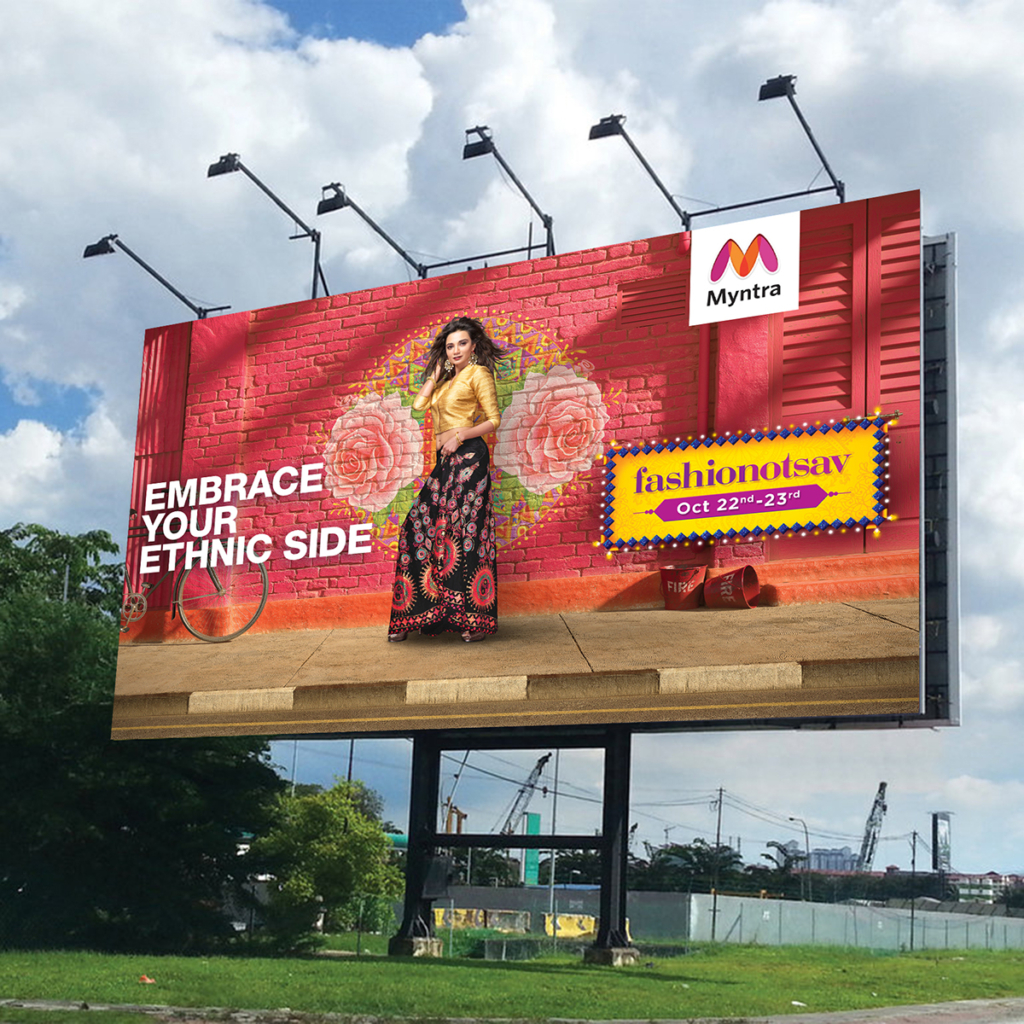
Image credit- Afaqs
Both businesses saw enormous success as a result of their marketing plans and ad operations. These businesses would still be unknown if they had not reached their target audiences at the correct time and through the right channels. Zomato and Myntra needed to avoid bombarding customers with frequent and unnecessary ads to provide an excellent customer experience. They were aware of the demographics and preferences of their audience. Both businesses achieved the ideal mix between client satisfaction and revenue generation. The organizations were able to make informed decisions due to their comprehensive insights.
The Future of Ad Ops in India
Ad operations teams will need to embrace newer platforms and follow the lead of younger demographics as the Indian advertising market continues to grow. Digital-out-of-home (DOOH) advertising tools are among the new technologies that enable marketers to reach audiences in public spaces with customized content. Moreover, it’s clear that ad operations are no longer only a tactical role. Ad operations teams are already becoming more strategic, leveraging technology to solve business challenges and playing a key role in revenue growth because of their close relationship to revenue. However since digital media is always changing, ad operations professionals should expect to face a number of new difficulties in the coming years.
- The volume of campaigns will keep growing at an exponential rate.
- The range of available ad formats will increase.
- Utilizing first-party data effectively will be essential—even more so than it is now.
- Changes in policy will be implemented on a worldwide, regional, and national scale.
- There will be more pressure on companies to maintain high margins while increasing revenue.
- Publishers will see that ad ops teams with a tech focus can directly affect revenue.
- Ad ops teams’ increased awareness of revenue workflows and data will help them move closer to the strategic side of the business.
Another important factor in digital marketing will be the development of technology. Fortunately, generative AI has made it simpler for ad operations teams to create more content in greater quantities intended for multiple channels. This technology can be used by ad operations specialists to test ad tech platforms, generate and evaluate audience segments, and produce content in a variety of formats. Ad operations teams can concentrate more on gathering information and using data-driven insights to guide marketing and revenue decisions as generative AI enhances automation.
Final Words
Ad Ops is increasingly playing a crucial role in the Indian advertising sector by enhancing efficiency, targeting, and campaign effectiveness. In this industry, automation and personalization must be carefully balanced. Ad operations will be essential in ensuring ad viewability and brand safety as the advertising landscape changes. Cheers to the growth of ad operations and their bright future in the Indian advertising industry.
Read More: Cricket’s Advertising Blitz: Boundaries Beyond the Game!
After Meta, E-commerce Giant Amazon Taps Snapchat For In-App Shopping Feature
Amazon announced that it will enable Snapchat users in the U.S. to make direct purchases from the social media platform for select Amazon products. Customers will be able to shop straight from Amazon ads for Snapchat and check out without ever leaving the app thanks to the partnership. The move is part of the e-commerce giant’s strategy to profit from the rising popularity of social media shopping.
Rise of social media influence on e-commerce firms
Some platforms, like TikTok, are launching their own online shopping services as a result of social networks’ growing influence on shopping trends and patterns. Conversely, e-commerce companies can access the subscriber base through other social media platforms such as Snapchat.
Benefits to Snapchat from the e-commerce integration
Snap, which has reported higher-than-expected revenue and user growth over the last three months, would benefit from the deal. Additionally, the data shows that marketers are reverting to using smaller platforms like Snapchat.
Read More: Amazon Announces Publisher Cloud to Plan Programmatic Deals in Amazon DSP
Amazon – Snapchat partnership
On some Amazon products, prospective customers will also be able to view real-time pricing, Prime eligibility, delivery estimates, and product details on Snapchat. It comes after the e-commerce behemoth’s agreement with Meta, which permits users of the online retailer to link their Facebook and Instagram accounts to Amazon and make purchases straight from the social media platforms. Amazon and Pinterest have a similar partnership. The collaboration might facilitate Snap’s advertising business’s comeback.
Here’s what they said
Amazon spokesperson said in a statement,
Customers in the U.S. will see real-time pricing, Prime eligibility, delivery estimates, and product details on select Amazon product ads in Snapchat as part of the new experience. In-app shopping with Amazon is available for select products advertised on Snapchat and sold by Amazon or by independent sellers in Amazon’s store.
Read More: Meta and Amazon Collaborate for In-App Shopping in FB and IG



